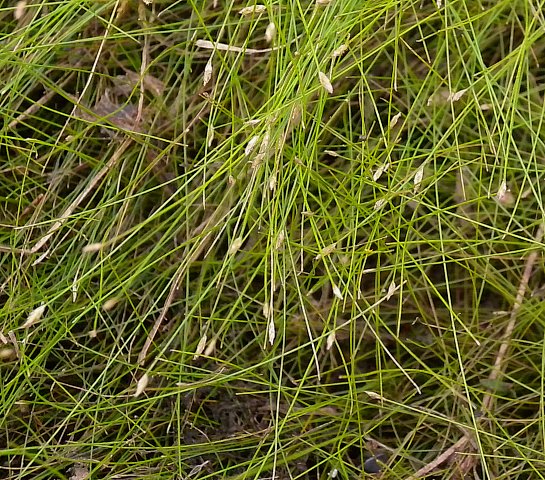
The blooming period can occur from mid-summer into the fall, lasting about 2 weeks for a colony of plants. The florets are cross-pollinated by wind. Each fertile floret is replaced by a tiny achene that is about 0.6-0.8 mm. in length and 0.2-0.4 mm. across at maturity; the body of this achene is light brown and oblanceoloid to obovoid in shape with 9-15 longitudinal ribs (requires 10x hand lens to see). At the apex of the achene body, there is a conical tubercle with a slightly swollen base that is green or white. The base of this tubercle is more narrow than the apex of the achene body. From the base of each achene, there originates 0-4 fine bristles that are a little shorter than the achene. These bristles break off easily and they are sometimes absent. The achenes are small enough to be blown about by the wind or they can be carried by currents of water. The root system is fibrous and rhizomatous. Dense colonies of plants with a mat-like appearance are often produced from the rhizomes. The culms of these colonial plants
Cultivation: The preference is full sun, wet conditions, and soil containing silt, sand, or mud. This spikerush can adapt to wet ground or shallow water. There is also a form of this spikerush that is fully aquatic (f. submersa); this latter form is sterile. Non-alkaline water pH is preferred. Most growth and development occurs during the warmer summer months.
Range & Habitat: The native Needle Spikerush is common in NE Illinois and occasional in other areas of the state. This applies to the typical terrestrial form of the plant. The aquatic form of this plant (f. submersa) has been observed only in McHenry County. In addition to North America, Needle Spikerush also occurs in Eurasia. Habitats consist of marshes, sedge meadows, calcareous seeps, borders of ponds, and clear shallow water of ponds. Sometimes the aquatic form of this plant is cultivated in terrariums.
Faunal Associations: Several species of leaf beetles and leafhoppers are known to feed on Eleocharis spp. (spikerushes). These species include the following leaf beetles: Plateumaris aurifera, Plateumaris dubia, Plateumaris fulvipes, Plateumaris germari, Plateumaris nitida, and Plateumaris robusta. Similarly, the following leafhoppers feed on these plants: Deltocephala gnarus, Dorydiella kansana, Limotettix bisoni, Limotettix elegans, Limotettix nigrax, Limotettix parallelus, Limotettix pseudosphagneticus, Limotettix truncatus, and Macrosteles potoria. Other insect feeders include caterpillars of Cisseps fulvicollis (Yellow-Collared Scape Moth) and possibly caterpillars of Oarisma poweshiek (Poweshiek Skipperling). Some of these insect species are associated with wet prairies and they are quite rare. The seedheads of spikerushes are eaten by such wetland birds as rails, coots, ducks, and geese (see Bird Table). In addition, the foliage and/or roots are eaten by the Canada Goose and muskrats (Martin et al., 1951/1961; Hamerstrom & Blake, 1939).

Photographic Location: Along the shore of a pond near Champaign, Illinois.
Comments: This is one of the smallest spikerushes (Eleocharis spp.) within Illinois. It can be reliably distinguished from other small species in this genus by its achenes: each of its achenes has a distinctive oblanceoloid or obovoid shape, a small conical tubercle with a swollen base, and 9-15 longitudinal ribs. An exception to this rule is Eleocharis wolfii (Wolf's Spikerush), which has very similar achenes. However, this latter species is a taller spikerush with wider culms (0.5-1.0 mm. across) and longer scales on its spikelets (2.5-3.0 mm. in length). Without the spikelets and achenes, Needle Spikerush cannot be reliably distinguished from Eleocharis intermedia (Intermediate Spikerush) and other small spikerushes.